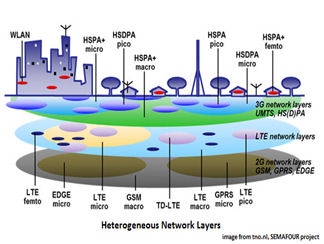The case for Self-Organizing Networks
Mobile Operators are facing unprecedented data growth in their networks resulting in financial and technical challenges. These challenges require not only new tools and techniques but new thinking to resolve.
September 23, 2014

Telecoms.com periodically invites expert third-party contributors to submit analysis on a key topic affecting the telco industry. In this piece Michael Motta, Director of Product Marketing at PI Works, discusses the merits of Self-Organizing Network (SON) technology at a time when hetnets are playing an increasing role in tackling exponential mobile data demand.
Mobile Operators are facing unprecedented data growth in their networks resulting in financial and technical challenges. These challenges require not only new tools and techniques but new thinking to resolve.
The explosion of video streaming puts stress on network infrastructure not only due to amount of data but also because of tight latency requirements. It is becoming much more difficult to plan and manage network resources to achieve an excellent subscriber experience, where delay-tolerant data services co-exist with real-time delay-intolerant voice and video services.
In order to increase cell capacity to support the increased data traffic, the distance between a base station and subscribers needs to be reduced. This means deploying a significant number of small cells, which interact in complex ways with each other and with the macro network.
This emerging heterogeneous network will become unmanageable without new tools and techniques. Operators have to rethink how the performance management and optimization processes work.
The heterogeneous network requires different kinds of complexity to be managed:
vendor diversity with different versions of vendors’ equipment,
complex topology of network elements,
the logical consistency of connections between different connection layers,
different radio technologies on a multitude of frequencies, and
the sheer size of the network in terms of increased numbers of network elements
Network engineering staff will need to be increased in order to address these challenges in the traditional way. The only realistic alternative is to make extensive use of automation to empower the team to face the new complexity without a need to increase staffing.
There are three key attributes of the new set of tools for continuous network quality improvements:
Unified view on network configuration and performance, using detailed visualizations across all elements. Performance and quality improvements in heterogeneous networks is directly related to the ability to get all nodes under a common management framework, including small cells, macro cells, WiFi access points, and backhaul. The operator will need a single, integrated set of tool to avoid moving back-and-forth between different specialized databases and tools,
Access to complete and accurate integrated data in near real-time to be able to quickly respond to the changing network conditions,
Automate the tool chain, performance monitoring with dynamic KPI evaluation, reporting, alarm management, and optimization. Self-Organizing Network (SON) forms the core of the technology to bring compelling value throughout the entire network engineering workflow from problem detection through to resolution
SON solutions have been simulated for some time behind the closed doors of the classroom and in laboratories. More recently, SON solutions have matured in methods to represent and act on deep domain knowledge of the radio access network. A well-designed SON solution can drive and sustain high network quality by finding improvement patterns not immediately visible to even an expert eye. Network parameter modifications and rollback algorithms have improved based on rich statistical models of KPIs, their dependencies and interactions.
New automated mechanisms are now available to prevent conflicts between various optimization functions such as mobility robustness and load balancing running at the same time. In combination with expert services teams, field experience is being built-up in live network deployments and built-in to SON solutions for more effective results. SON offers self-learning algorithms to improve accuracy over time. But most importantly, SON has proven its value in the real world. The anxiety about the value and risk of SON solutions will only be changed based on real-world examples of success.
As with any mission critical, next generation solution, you have to ask “what’s in it for me?“, “How can I take best advantage of the new opportunities presented by SON?” A few key reasons are given below about why SON is worth considering and some hints to get the most out of it.
You can’t just flip a switch for SON improvements. Deploying SON solution in your complex network requires carefully considered objectives. You need to tailor the configuration to your unique network in order to address problems of customer experience, coverage and capacity, energy savings, and to reduce dropped connections. You need RAN experts to use automated network monitoring and optimization tools to understand what’s going wrong, and where to apply the right SON automation with the correct parameters in compliance with your policies. SON Solutions must be tuned to your network.
Centralized SON helps to make more reliable decisions. Centralized SON (C-SON) provides a unified view of your complex network KPIs as a basis for making smart optimization decisions. As compared with Distributed SON (D-SON), C-SON tools should gather data from all network elements in near-real time. C-SON coordinates SON optimization actions over groups of nodes without n2 communication inefficiencies of D-SON (every node talking to every other node). C-SON allows inter-technology (GSM, CDMA, UMTS, LTE, WiFi) interactions to be managed across equipment vendors. You need to consider a high availability distributed C-SON configuration used to eliminate single point-of-failure problems.
There needs to be transparency of the SON automation processes. Inability to audit the history of detailed changes in real-time introduces needless uncertainties about the effectiveness of automated optimization. You need rich monitoring and direct visualization capabilities to show current network state and status of SON optimization actions as well as configuration audits to show all changes to the network as correlated with changes to KPIs. This helps to improve your confidence that SON is addressing your needs.
SON improves Customer Experience. Since more than 50% of mobile data is video streaming, downlink (DL) throughput improvements and reduced dropped connections directly and significantly impact positive end-user experience. For example, the 3GPP-defined Coverage and Capacity Optimization (CCO) SON function directly targets inter-cell interference, the main interference source limiting downlink data throughput. Mobility Robustness (MRO) functions help to minimize dropped connections, which disrupt data session continuity. SON can also offer a proactive subscriber experience management capability linked to the network performance. Changes brought about by particular implementations of these SON functions allow you to monetize increasing data usage while improving the end-customer experience, especially for streaming data applications.
SON enables network staff to be more productive. It is very difficult for your engineering staff to identify and to resolve problems manually in the complex heterogeneous network. SON reduces the need to hire more engineers, and increases the accuracy of the applied solutions to network problems with the same amount of engineering staff. An integrated SON solution will need to cover all network engineering workflows showing results in near real-time.
CapEx efficiency is increased using SON. SON allows you to flatten your CapEx spending by extracting more from the existing network assets. Shorter lead-time to revenue is achieved by significantly reducing the time to bring up new access elements. Short data integration times allow you to put the benefits of SON to practice quickly and to stay up-to-date with the ongoing changes in your network.
Success in SON is based on real deployment experience. SON has finally moved from the laboratory to actual deployments in live networks. To develop the trust of radio engineers for automated management systems, your SON solution design should be based on significant practical experience in optimization of complex mobile networks.
Self-Organizing Network Solutions can offer unprecedented ability for the mobile operator to get and keep their complex heterogeneous network performing at peak efficiency. The right SON solutions help to drive significant savings in OpEx, to increase capital spending efficiencies, and improve the quality of end-user experience leading to increased revenues. After years of tinkering, the time for SON has finally come.
 Michael Motta is Director of Product Engineering at PI Works. P.I.Works provides SON solutions to improve the performance of Mobile networks worldwide. Their purpose-built tools support performance monitoring and automated network optimization using Self-organized Networks (SON) techniques.
Michael Motta is Director of Product Engineering at PI Works. P.I.Works provides SON solutions to improve the performance of Mobile networks worldwide. Their purpose-built tools support performance monitoring and automated network optimization using Self-organized Networks (SON) techniques.
Read more about:
DiscussionAbout the Author(s)
You May Also Like








.png?width=300&auto=webp&quality=80&disable=upscale)


_1.jpg?width=300&auto=webp&quality=80&disable=upscale)


.png?width=800&auto=webp&quality=80&disable=upscale)